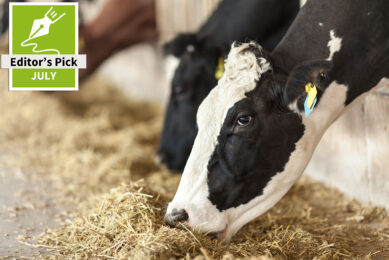Enhancing dairy performance by optimising dietary fibre utilisation

World-leading experts discussed the role of plant fibre in dairy nutrition at a scientific symposium organised by the University of Bologna (Italy) with the support of Lallemand Animal Nutrition and Filozoo Italy.
Under the title “Fibre: a key element for dairy production profitability?” presentations of world-leading experts in dairy nutrition and microbiology attracted over 300 participants from all over Italy as well as 24 different countries around the world. Offering a good combination of high level scientific content and practical field recommendations delivered by top-notch scientists in the field, the symposium generated rich and enthusiastic discussions, and will certainly lead to the development of new feeding strategies and herd management practices.
In today’s economic and climatic context, the trend is to increase the proportion of fibrous ingredients in ruminant diet and it is crucial to be able to extract the maximum of energy and nutrients from this fibre fraction, in order to increase Income Over Feed Cost (IOFC). In this setting, it is important to have a better understanding of fibre digestion and utilsation by ruminants, and the factors that affect this, including non-dietary factors (the animal development at earlier stage, its feeding behaviour, etc.), as well as environmental factors which affect what is commonly referred to as fibre quality (draught, temperatures, plant maturity, etc).
Rumen as fibre degrader
The rumen is incredibly able to utilise fibre, in particular from young and barely lignified forages. The fibre indigestible fraction is related to the lignin content of the cell wall, but this relation is not
constant, as so far thought. To be utilised fibre is selectively retained into the rumen for a long time, while teeth reduce particle size during eating and rumination. The major part of the fibre dietetic role is due to the ability of forages (the main fibrous compound of any diet) to stimulate chewing activity; native structure (straw is more efficient than grass, and grasses are more efficient than legumes) and particles size and shape are probably the main factors involved.“More chewing activity can slow down the feed intake rate, which is important to prevent a dangerous amount of digestible organic matter in the rumen,” said Dr Andrea Formigoni, of the University of Bologna. “Also it increases saliva production, which has a buffering effect, and it improves rumen motility and passage rate.” Adequate dietary fibre levels can also improve digestion efficiency, positively affecting pH dynamics in the rumen, Formigoni added.
Dynamic process
“Degradation of fibre is the result of the competition between passage rate and degradation,” explained Dr David Mertens, Mertens Innovation & Research LLC, Wisconsin, USA. He highlighted the fact that fibre degradation is a dynamic process, influenced by intrinsic and extrinsic factors (Figure 1). The passage rate defines the time fibre is retained in the rumen for fermentation. It is primarily a function of feed intake and fibre particle size (small particle size leads to lower retention time and digestibility).
Mertens divides fibre degradation kinetic into three phases (Figure 2):
- An initial lag phase, where fibre becomes hydrated and fibrolytic microbiota adhere to plant cell walls;
- A rate phase where the potentially degradable fibre fraction is digested at a constant rate (varying between 0.02 and 0.16/h), and
- A plateau phase which is determined by the indigestible NDF.
The indigestible fibre in forages is related to lignin concentration, but the relationship is not constant. It also contains some structural carbohydrates (cellulose and hemicellulose) which are ‘trapped’ with lignin. Understanding fibre degradation and its numerous influencing factors reveals some keys to improving feed efficacy. “To optimise fibre digestion, we need to minimise the indigestible fibre fraction, maximise rate of fibre digestion, and maintain a ruminal environment that maximises the population of fibre digesting bacteria,” concluded Mertens.
Reducing lignin and decreasing the maturity of forages will result in the most rapid and complete degradation of fibre. The non-fibre fraction of the diet can also have an effect, for example, high starch and associated low rumen pH can negatively affect fibre digestion. It was shown to decrease lag phase and degradation rate and increase indigestible NDF. Furthermore, longer particles have a longer retention time and feed intake affects rate of passage: retention time is decreased with high feed intake and fibre digestion decreases. Mastication and rumination have an effect on fibre digestion.
Internal factor
“The rumen microflora is a well-organised cooperative ecosystem which is responsible for the transformation of fibre into VFAs,” explained Dr Frédérique Chaucheyras-Durand from French research institute INRA. The rate and extent to which fibre is degraded depends on physiological characteristics of these fibre degrading microbes, microbial interactions or physico-chemical conditions of the ruminal environment, such as pH or redox potential (low pH increased lag and decreased rate of NDF digestion).In vitro and in vivo studies have demonstrated that a specific strain of Saccharomyces cerevisiae (SC I-1077) increases degradation of fibrous materials by promoting substrate colonisation by rumen bacteria and fungi. Active dry yeast can positively affect fibre digestion in the rumen, which should lead to increased feed efficiency and optimised animal health. Chaucheyras-Durand also concluded that interactions are complex and depend on the nature of the substrate and the microorganism species. “High throughput tools such as functional DNA microarrays should help to better understand the action of such additives within a complex system, and further select for new generation products,” she said.
Rumen modifiers
Dr Charles Sniffen, Fencrest LLC, New Hampshire, USA, defined rumen modifiers as “feed additives which alter ruminal fermentation, microbial growth with positive impact on feed efficiency”. He lists in this category: ionophores, live yeasts, yeast fermentation products, fermentation products, essential oils and enzymes.
Sniffen focused on advanced nutritional programs that use the biology to model ration formulation such as CPM or CNCPS. He is developing sub-models to take into account the effect of rumen modifiers which positively affects the rumen function and feed efficiency. For this, the precise modes of action of the additive have to be elucidated (e.g. SC I-1077 modifies pH, improves anaerobiosis, enhances microbial growth). Such sub-models would help to formulate rations that reflect the responses from the different modifiers available.
He concluded that, “when these additives are well documented in terms of mode of action and feed efficiency, they can be incorporated into diets formulation to improve zootechnical results.” As was shown by Dr Chaucheyras-Durand, SC I-1077 helps improve microbial fibre degradation in vivo. This benefit seems to be linked not only to the crop tested but also to the quality of the crop fibre. This effect is usually greater for lower quality forage (low digestibility), which suggests that SC I-1077 could help to reduce indigestible NDF by promoting the action of bacteria and fungi (Figure 3).
Limits and future of nutritional models
Dr Alex Bach, from Spanish research institute IRTA, demonstrated the limits of interpretation of experimental models versus real life conditions in a commercial dairy herd: “Nutritional models calculate nutrient requirements under the assumption that animals have ad libitum access to feed and water and are kept under dry and clean conditions. But influence of management and environmental factors needs to be precisely measured: they directly influence eating and lying behaviour of cows, which affect rumen function, digestion, and, finally feed efficiency.” Based on a large-scale survey involving 47 dairy herds, Bach showed the importance of individual variations within a herd, let alone between herds. He also showed examples of discrepancies between an ‘ideal’ model and real life situation. For example, as seen earlier, long particle size is favourable to decrease passage rate but is often segregated by the animal.
Photos: Yanne Boloh











